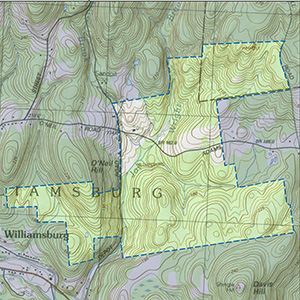Important Bird Area Sites in Massachusetts
Important Bird Area: Graves Farm Wildlife Sanctuary
Site Summary
Nominated By
Geoff LeBaron, Mara Silver
Size
543 acres
Towns and Counties
Greenfield, Williamsburg; Franklin, Hampshire
Ownership
Mass Audubon
Major Habitats
northern hardwood forest, cultural grassland, palustrine woodland swamp, shrub-scrub wetland, lake/pond, river/stream
Land Use
nature & wildlife conservation/land trust; research; undeveloped
Serious Threats
introduced animals or feral pets, succession
Minor Threats
non-native invasive plants
IBA Criteria
- Category 2: Sites important for long-term research and/or monitoring projects that contribute substantially to ornithology, bird conservation, and/or education.
- Category 4: Sites containing assemblages of species characteristic of a representative, rare, threatened, or unique habitat within the state or region.
- Category 5: Single-species Concentrations: The site regularly supports significant concentrations of a flocking species, but may not meet the thresholds above. The site should support a higher proportion of a species' statewide population (more than 1%, if known) than other similar sites.
Site Description
Graves Farm Wildlife Sanctuary land is located in the towns of Williamsburg and Whately. Of the property's 543 acres, approximately 498 are mixed coniferous/deciduous forest, 40 are annually mowed former hayfields, and six are wet meadow, including a small cattail marsh. Two streams, Potash Brook, and Joe Wright Brook, cross the property. The topography varies from low-lying wetlands and small hills to steep rocky ledges. Beaver activity on Joe Wright Brook has created a pond and flooded the forest. Another pond lies adjacent to one of the hayfields. Of note is a mature hemlock forest of approximately 30 acres and impressive 75-foot ledges along Joe Wright Brook.
Current Conservation Status
This IBA is a Mass Audubon sanctuary. House Sparrows compete aggressively on the sanctuary with breeding Cliff Swallows, Eastern Bluebirds, and Tree Swallows. For the past 11 years, House Sparrow control measures have been implemented during the breeding season. Succession is a threat to the hayfields, so the fields have been mowed annually since 2000. A National Resources Conservation Service (NRCS) grant was awarded to Mass Audubon for restoration and management of the grassland. This grant will provide funding for management through October 2002.
Ornithological Significance
The Cliff Swallow, although not a federally listed or state listed species in Massachusetts, is informally watch listed in Massachusetts. The Cliff Swallow colony at Graves Farm has been monitored annually since 1991. There is also a good representation of the breeding species of the region and a high density of territories that appear to have been stable over time. The maximum number of Cliff Swallows was 63 pairs in 1993. Bobolinks nest in the fields.
Other Flora or Fauna of Significance
Daisy-Leaf Grape-fern and Autumn-willow are watch-listed plants. The Baltimore Checkerspot is a local and uncommon butterfly that occurs at the farm. The Spring Salamander has been documented in Joe Wright Brook. The Elderberry Longhorn Beetle has also been documented on property. A great diversity of aquatic invertebrates are present in Joe Wright Brook.
Data Sources
Silver, M. 1993. Second-year management of a cliff swallow colony in Massachusetts. Bird Observer 21(3):150-155.
Silver, M. 1995. Conservation of Cliff Swallows in Massachusetts. Bird Observer. 23(6): 327-332.
Christmas Bird Count data: Published annually by the National Audubon Society in the Christmas Bird Count volumes of Audubon Field Notes and American Birds from 1935 to the present.
Silvio O. Conte National Fish and Wildlife Refuge Migratory Bird Stopover Habitat Use Survey, 1996-1998




